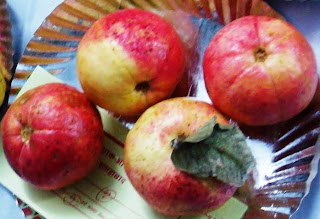The other day “The Hindu”
brought out a feature on the guavas of Allahabad. Allahabad has, seemingly,
always been famous for guavas. Since childhood we used to hear hawkers carrying
basketfuls of guavas on their heads calling out “Ilahabad ke amrud” (guavas of
Allahabad). We did not know whether they used to be really from that blessed
place. More than sixty years ago it seems rather farfetched that guavas of
Allahabad would travel all the way to Gwalior in Central India where I was
growing up the early 1940s and 1950s. But, then the hawkers had their own way
of attaching, what has since come to be known as, Geographical Indication of
the products that they hawked. Thus, we had “Hoshangabad ke tarmooz” (Water melons from Hoshangabad), “Nagpur ke Santre”, (oranges from
Nagpur), “Malihabad ke dussehri”
(dussehri mangoes from Malihabad), “Bambai
ke hapus” (Alphonso mangoes from Bombay), “Chaman ke angoor” (grapes from Chaman, Afghanistan), and so on. Over
the years, this district-wise specialisation in production of fruits seems to
have been wiped out with the economic, scientific and agricultural, especially fruiticultural
progress that the country has made. Everything virtually is being grown
everywhere and numerous places have, as a consequence, lost the tags they
earlier had attached to them for production of some specific fruits.
 |
| Khusro Bagh |
Guavas of Allahabad, however,
are different. They stand out even today and, to my knowledge, their production
has not been replicated anywhere else. It is indeed unique, like of which I had
never seen before. One would normally think that guavas of every place are more
or less the same. It is not so; the difference is to be seen to be believed. I
could not believe my eyes the first time I set my eyes on them in the main
square of Allahabad. A couple of hawkers were hawking them piled up on their
baskets. They looked like apples from Himachal or Kashmir – red, either all
over or interspersed with yellows, and were well-rounded – a beautiful looking
fruit. Inside it has pink meat and as one bites into it one gets a very
pleasant fragrance. Red, apple-like guavas are grown in some countries but, I
dare say, the ones of Allahabad are unique as far s this country is concerned.
Of course, there are various
varieties that orchards around Allahabad produce but the red one is what beats
them all. Known as “Surkha”, meaning
red, it gets better as the winter chill increases. Now that the cold weather has
set in, the fruit, apparently, is available in plenty. I saw videos of Kumbh
Mela where Westerners were found biting into the delectable fruit sitting on
the sands near the Sangam, the
confluence of Ganges, Yamuna and the extinct river Saraswati. Having a very short shelf-life, it is
generally not amenable to transportation over long distances. During our visit
a few years ago, we did not find it in Varanasi which is a hundred-odd
kilometres from Allahabad. At Lucknow it was just not there, presumably, being
a little too far out for its comfort.
 |
| Anand Bhawan |
Allahabad has more to it than
just “Surkha” and Kumbh at “Sangam”. It has Khusro Bagh, a 17th
Century walled garden, in which are located the mausoleums displaying exquisite
architecture of Emperor Jehangir’s son Khusru, his sister Nithar and their
mother, Emperor Jehangir’s first wife who was a Hindu. It also has a 16th
Century fort built by Emperor Akbar. The University of Allahabad, once known as
the Oxford of the East, is located here. Anand Bhawan, the house built by
Motilal Nehru is another attraction having been an important scene of action
during the country’s freedom struggle. Allahabad also offers in its bustling
Chowk some delicious spicy eastern Uttar Pradesh cuisine.
_____
Photo of red guavas is from Internet. Those of Khuro Bagh and Anand Bhawan were taken by me




No comments:
Post a Comment